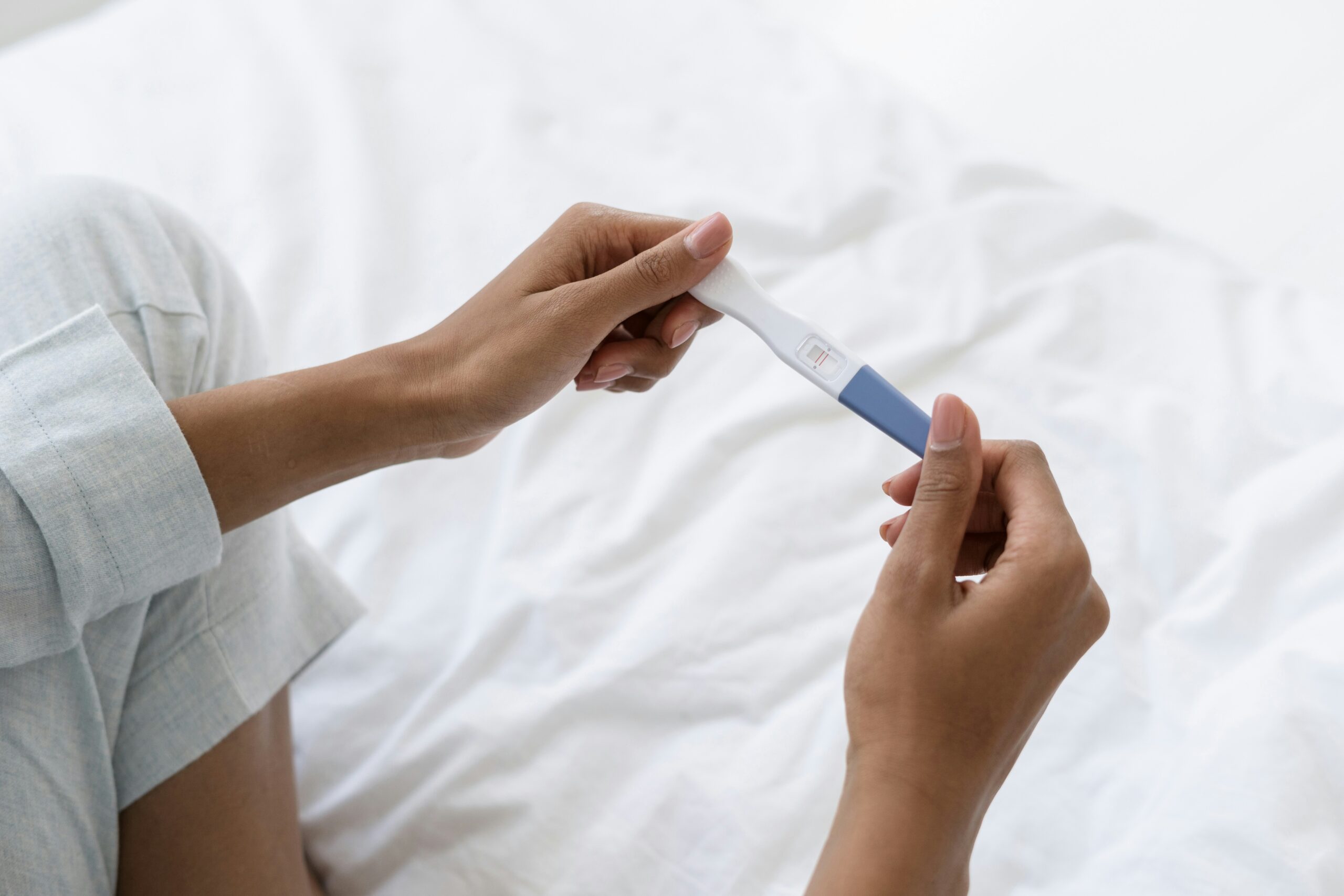If you’re trying to conceive, you know how ovulation plays a key role in the process. But there’s a lot more that goes into it than you might realize when you are first beginning your journey. Understanding what ovulation is, how it works, when it happens and the best ways to track ovulation can increase your chances of getting pregnant.
Essentially, ovulation is the phase in your menstrual cycle where your ovary releases one of your eggs. “Conception isn’t possible without ovulation. Ovulation is the time when one of your ovaries releases a mature egg, which travels down the fallopian tube and is ready to be fertilized by sperm. If sperm are present in the fallopian tube when you ovulate, they can fertilize the egg—marking the first step toward pregnancy,” Dr. Amy Divaraniya, PhD, the founder and CEO of Oova, a company providing at-home hormone-testing kits, explained. “While ovulation typically occurs around 14 days before your next period, it can happen earlier or later depending on the length of your cycle.”
According to Oova’s research, while a majority of people believe they have a 28-day cycle, only 5 percent actually do. This is where at-home hormone monitoring can help, ensuring you know exactly when you’re ovulating.
Whether you want to be prepared when it comes time or you’ve been trying to conceive for a while, having the knowledge about ovulation can make all the difference in your trying-to-conceive journey. Another way to better understand your unique cycle is through fertility awareness methods or FAMs. You can use FAMs, like body temperature or the cervical mucus method, to help track your cycle and receive clues on what’s happening each day of the month. Here, we’ll cover:
- Ovulation Prediction Kits (OPKs)
- Basal Body Temperature (BBT)
- Cervical Mucus Method
- Ovulation Calendar and Apps
- Combining Methods
- When to Seek Medical Advice

Ovulation Prediction Kits (OPKs)
Ovulation prediction kits, or OPKs, are one of the best ways to track ovulation for conception. These tests work by detecting a rise in your luteinizing hormone, or LH, in your urine. A rise in LH signals the ovary to release an egg. Essentially, a positive result on an OPK test means that your ovulation period is likely to happen soon, which gives you an idea of your best window for conception. OPKs are roughly 97 percent accurate in detecting the LH surge. However, like many medical tests, they can produce false positives or negatives.
To use an OPK effectively, start testing a few days before your halfway point in your cycle. Test every day for these couple of days; you can even test twice a day to ensure you pinpoint the LH surge. Always follow the instructions on your OPK for the most accurate results. Lastly, tracking your results over time can help you better understand your ovulation cycle. You can write down when your LH is surging in your planner or notes app to help keep track of everything, or use apps like Premom to analyze your results and make predictions.
Basal Body Temperature (BBT)
Another way to track your cycle is through your basal body temperature. This is your temperature when you’re fully at rest. Why does this matter? When it comes to ovulation, your basal body temperature might rise slightly, so you will be most fertile during the two to three days before your temperature increases. This shift in temperature confirms that ovulation has occurred.
Tracking your BBT can be hard because you need to be extremely consistent. You have to take your temperature every morning before you get out of bed. You will also need to get three hours of uninterrupted sleep to obtain an accurate reading. After you take your temperature, record it in your notes app, a journal or an app.. Then, wait for your body temperature to increase, usually less than one-half of a degree. This is when you are ovulating.
For the most accurate results, you can actually buy a BBT thermometer. These thermometers are a little more sensitive to the slight temperature changes that happen during ovulation.
Cervical Mucus Method
Part of trying to conceive is also understanding your vaginal discharge. Dr. Jessica Vernon, MD, PMH-C, a board-certified OB/GYN, explained during the phase of your menstrual cycle when you are not fertile, your cervical mucus is thicker and harder for sperm to swim through However, during your fertile period, the mucus becomes thinner, clearer and stretchy. This is the “egg white” cervical mucus.
“You can touch your cervix with your fingers during this time if you reach up high enough in your vagina, which has a consistency similar to the tip of your nose,” Dr. Vernon explains. Then look at the mucus on your fingers: it will stretch between your fingers in thin strings like egg white.” This is fertile mucus and the sperm can easily swim through it to reach your uterine cavity and then fallopian tubes, where fertilization most commonly occurs.
Cervical mucus tracking does come with its own challenges. For some, it can be difficult to determine which type of mucus you have. However, it’s also a completely natural and cost-free way for you to track your ovulation.
Ovulation Calendar and Apps
Another common way to track your cycle might be something you already have that tracks your period: an app! After a while, the app can accurately track when you’re likely to ovulate. It even will highlight your most fertile days. With some fertility tracking apps, you can input your BBT, cervical mucus patterns or OPK results. With time, apps like these can become one of the best ways to track ovulation. Here are some of our favorite ovulation-tracking apps:
Flo
Flo tracks everything from your menstrual cycle to your period symptoms. When it comes to ovulation and fertility, Flo provides insights on your fertile window and ovulation days. This can help you get to know your body’s signals and signs that you’re ovulating.
Clue
Just like Flo, clue tracks your period and its symptoms. After getting to know your cycle, Clue tracks your ovulation and fertile window. It also has the option to switch to pregnancy mode, where you can track your pregnancy progress.
Premom
Premom is designed to support you by tracking your ovulation through data from OPK’s and your BBT. The app reads your ovulation test results through pictures. Then it provides insights into your peak fertile days.

Combining Methods
After learning about all of these methods, you might want to combine some of them, which can actually increase the accuracy of predicting your fertile window and be the best way to track ovulation. Each method has its benefits, so combining them can help you approach ovulation more confidently. For example, you can combine OPKs and tracking your BBT or combine a fertility app with any of the methods to help you see patterns over time.
When to Seek Medical Advice
Deciding when to seek a healthcare provider for fertility concerns really depends on how you feel and when you need assistance, advice or guidance. “Generally, it’s recommended to seek help if someone has been trying to conceive for over a year without success, or six months if they are over 35. Those with irregular menstrual cycles or conditions like PCOS should also consider consulting a reproductive endocrinologist, especially when trying to conceive,” Dr. Divaraniya said. “Ultimately, it depends on the individual, and it’s important to consult with a primary care physician or OB-GYN to determine the best course of action.”
Also, if you’re ever feeling overwhelmed or concerned about the best ways to track ovulation for you, reaching out to your healthcare provider can help. They can answer any questions or address concerns you may have.
From OPK’s, your BBT, your cervical mucus and fertility apps, all of these methods can help you figure out your most fertile days and give you the best chance at a pregnancy. Remember, with any of these methods, stay consistent! Make sure you’re adding whatever method you choose to your daily routine.
Also, remember that fertility can be a long journey, so patience is key. If you ever want more personalized guidance, don’t hesitate to contact your healthcare provider. They can get to know your body and habits to figure out what works best for you. With the best ways to track ovulation, consistency and patience, you can get there.
Author
-

Esha Minhas is a third-year student at Northeastern University studying Journalism and Political Science. She's currently the editorial and social intern for Mila & Jo Media. Esha is also the Deputy Sports Editor for The Huntington News and covers Northeastern men's hockey. When she's not busy with work or school, you can find her at the gym, baking for her friends and family and watching anything sports related.
View all posts





